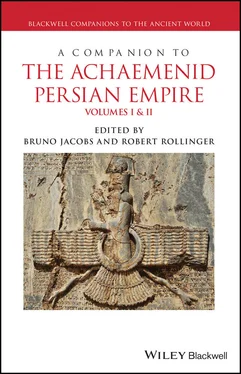As we do not know whether these Madāya had a supra‐regional Median identity, we are also ignorant about whether they represent a homogenous linguistic group. Although the many “Median” proper names that we have, thanks to the flourishing cuneiform and later especially Greek sources, reveal a dominant Iranian background of these people, one should be cautious about claiming that this evidence definitely proves a homogenous and well‐defined Iranian language, generally and simplistically labeled “Median.” Such a hypothesis, although very common and likewise broadly accepted as fact, does not rest on firm ground (Schmitt 2003; Rossi 2010, 2017). It is highly probable that behind these proper names lurks a much larger and more complex diversity of local Iranian dialects/languages. And certainly, we have to reckon with a larger ethnic diversity in general in these areas where Urartian, Hurrian, Elamite, Assyrian, Babylonian, and other languages played a certain role (Fuchs 2011).
Over the 200 years of rather extensive Neo‐Assyrian documentation there is not a single piece of evidence for a unified political entity in the central Zagros region, let alone for a Median “empire.” Instead, these sources depict a highly fragmented political landscape in the Zagros mountain region, with no discernible tendencies toward greater centralization. The Assyrians encounter a plurality of small political units, whose rulers they call not “king” but “city lord” ( bēl āli ). Although transhumance was highly important in these regions, horse breeding and trade/robbery also played an important role, since the Khorasan road, i.e. the predecessor of the Silk Road, crossed the central Zagros area. In any case, the Assyrian sources never describe the Medes as nomads but always as a sedentary population. Intensive contact with the Assyrian super power and its gigantic economic space was highly influential in these regions, especially when with the reign of king Sargon (721–705 BCE) the Assyrians began to establish provinces. These contacts certainly transformed local societies and may also have triggered developments toward political unification that can be described as “secondary state formation” (Brown 1986; Rollinger 2020b), although this process never became a supra‐regional phenomenon. This conclusion is confirmed by archeological sources that, likewise, do not indicate the existence of a unified Median state. Important sites like Nush‐e Jan, Godin Tepe, Baba Jan Tepe, or Ozbaki Tepe do not represent “imperial centers” but rather seats of “city lords” with no more than a local reach (Liverani 2003; Stronach 2003; Gopnik 2011). Previously identified seats of power of an alleged Median “empire” in western Iran, like Hamadan, or outside the proper central Zagros area, like Kerkenes Dag˘ı in Asia Minor, do not hold up to critical scrutiny and have been revealed as optimistic academic mirages, constructed to fit preconceived notions of imperial Media (Boucharlat 1998; Sarraf 2003; Rollinger 2003b).
By about the middle of the seventh century BCE Assyrian sources on the Medes become scanty. They reappear on the political stage when the Assyrian Empire fights a final struggle for existence in the last third of the seventh century BCE. Our main source for these events is a Babylonian chronicle, the so‐called “Fall of Nineveh Chronicle” (Grayson 2000: pp. 90–96). Although the Chronicle reveals a Babylonian perspective on the events, it does not deny that it was not only the Babylonian forces under their usurper king Nabopolassar (626–605 BCE) that brought the Assyrian super power to an end but a coalition of Medes and Babylonians, who even concluded a formal treaty of alliance (Rollinger 2003a, 2010; Fuchs 2014). The Medes are described as Ummān‐manda and led by a certain Umakištar (Cyaxares in Greek). Obviously they “descend” to Assyria but the origin and reach of Umakištar's reign remain obscure. They destroy the city of Assur in 614 BCE and, together with the Babylonians, Nineveh in 612. With this event Umakištar disappears again from the historical scene, although some Medes may have participated in the Neo‐Babylonian campaign to the last Neo‐Assyrian residence Harran to deliver the failing Assyrians their final blow (Rollinger 2003a).
The Medes prominently reappear in the inscriptions of the last Neo‐Babylonian king, Nabonidus (556–539 BCE) (Rollinger 2003a, 2010, 2020a). Three events focus on the Medes through a Babylonian lens. The first one is once more the city of Harran in Syria. Nabonidus claims that the Babylonians were unable to rebuild the temple Ehulhul of the moon god Sîn, allegedly destroyed by Medes during the final struggles of the Neo‐Assyrian Empire in 609 BCE, because the Medes were supposedly still “roaming around” for more than 50 years. This is clearly an ideologically biased view where an allegedly permanent Median presence in Syria during the first half of the sixth century BCE is made accountable for Babylonian inactivity to rebuild the temple. In the same way, the Medes are presented as archetypical temple destroyers, an uncoordinated and destructive mass of people, and thus as true barbarians. This also goes for the second event, when Nabonidus looks back on the fall of the Neo‐Assyrian Empire and describes the Medes as a destructive flood that ruined not only Assyria but also Mesopotamian cultic rites and cult centers. The third event is contemporaneous to Nabonidus, when he focuses on the end of Median dominance in the central Zagros area. In this context another Median leader is introduced 60 years after Umakištar. His name is Ištumegu (Astyages in Greek). The event in question is also addressed by the so‐called Nabonidus Chronicle originating in Persian times, although inscription and chronicle are not in accordance concerning the dating of the event (553 vs. 550 BCE). Ištumegu seems to have ruled a political entity of medium size around its center, Hagmatana (Agbatana or Ekbatana in Greek; Hamadan in modern times), which controlled a territory no larger than the central Zagros region. He is not presented as a relative of the former Umakištar, and his political and especially military instruments appear to have been much less developed than those of his predecessor. He is in control neither of northwestern nor of southwestern Iran. He is not characterized as suzerain and superior of the king of Anshan, i.e. later Cyrus the Great. Rather, it was the latter who took the initiative and campaigned against his northern neighbor and rival, whom he quickly overthrew, and plundered Hagmatana (Rollinger 1999, 2010, 2020).
With this event the Medes do not disappear from cuneiform sources. Media has a coda in Darius' Bisitun inscription (Rollinger 2005). It figures as a kind of supra‐regional entity reaching from eastern Anatolia to central western Iran and farther to the east, and as far as the southern Caspian Sea. At first glance, one may take this as evidence for the extension of a former Median “empire.” But a closer look reveals that this is still a politically fragmentary and heterogeneous area, where several individual uprisings with different usurpers took place, only one claiming to be a descendant of the already legendary Umakištar. This evidence is thus best explained as a reflection of the reach of a very short‐termed confederation that owes its brief existence mainly to the special historical circumstances around the fall of the Neo‐Assyrian Empire.
The persistence of local traditions in a politically still fragmented landscape in these areas during early Persian times is also demonstrated by a much‐disputed passage of the so‐called Nabonidus Chronicle (ii 16) (Rollinger 2009; Rollinger/Kellner 2019). The passage deals with a campaign of Cyrus the Great in 547 BCE (the ninth year of king Nabonidus )toward a land which cannot be defined with absolute certainty because the text is partly broken. Only traces of the country's first sign are preserved rather badly, and it has been argued for about 100 years how to read this sign (Rollinger 1993: pp. 188–197). The discussion is characterized by the fact that such readings/interpretations have nearly always been presented as a “fact,” the tablet's bad state of preservation and the many different readings put forward notwithstanding. From the very beginning there was a mainstream opinion that the first sign of the country has to be read as Lu‐[xxx] and the country thus to be interpreted as Luddu, i.e. Lydia. This is the main reason for dating Cyrus' conquest of Lydia in 547 BCE. Divergent opinions concerning the reading of the sign have always been pushed aside, and this is also true in current discussions. In this context, astonishingly, it has been totally ignored that this discussion should not be based solely on the reading of the sign in question. Obviously the many differing opinions expressed on this problem in the last 100 years more than clearly demonstrate that the tablet's state of preservation is simply not sufficient to claim that the problem can be definitely solved by presenting this or that solution (cf. van der Spek 2014: pp. 256, n. 184; more cautiously: Payne and Wintjes 2016: p. 14 with n. 6). Rather, one has to contextualize the problem and look at the whole passage in question. There it is stated that
Читать дальше












